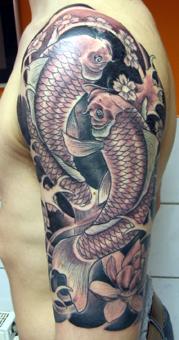Black-and-gray on:
[Wikipedia]
[Google]
[Amazon]
 Black-and-gray (also black-and-grey, black and grey/gray) is a style of
Black-and-gray (also black-and-grey, black and grey/gray) is a style of
 Black-and-gray techniques are often employed for a variety of tattoos. Japanese irezumi, such as the rising koi, are traditionally done using black-and-gray, although colored irezumi sometimes use black-and-gray backgrounds in a manner similar to sumi-e brushwork. Classic Chicano tattoos — which include a broad range of imagery such as icons in
Black-and-gray techniques are often employed for a variety of tattoos. Japanese irezumi, such as the rising koi, are traditionally done using black-and-gray, although colored irezumi sometimes use black-and-gray backgrounds in a manner similar to sumi-e brushwork. Classic Chicano tattoos — which include a broad range of imagery such as icons in
File:A045 afferni tattoo ritratto portrait.jpg
File:Mlght13.jpg
File:Man with a full back tattoo. Black and White image.jpg
File:A039-andreaafferni-seminars-seminar-tattoo-tattoos-tatuaggi-portrait-ritratto-realism.jpg
 Black-and-gray (also black-and-grey, black and grey/gray) is a style of
Black-and-gray (also black-and-grey, black and grey/gray) is a style of tattoo
A tattoo is a form of body modification made by inserting tattoo ink, dyes, and/or pigments, either indelible or temporary, into the dermis layer of the skin to form a design. Tattoo artists create these designs using several tattooing pro ...
ing that uses only black ink in varying shades. This tattooing style is thought to have originated from prison
A prison, also known as a jail, gaol (dated, standard English, Australian, and historically in Canada), penitentiary (American English and Canadian English), detention center (or detention centre outside the US), correction center, correct ...
s in the 1970s and 1980s and was later popularized in tattoo parlors.
Origin
Black-and-gray is sometimes referred to as "jailhouse" or "joint style" and is thought to have originated in prisons where inmates had limited access to different materials; they resorted to using guitar strings for needles and used cigarette ashes or pen ink to produce tattoos. Inmates would construct makeshift tattoo machines that were powered using the small motors available in tape players. Prisons generally prohibit inmates from tattooing, so these were likely to be done in secret. During the late 1970s and early 1980s, jailhouse then became popularized in tattoo parlors outside of prison and was renamed "black and gray". Black-and-gray is also thought to have originated from theChicano
Chicano or Chicana is a chosen identity for many Mexican Americans in the United States. The label ''Chicano'' is sometimes used interchangeably with ''Mexican American'', although the terms have different meanings. While Mexican-American ident ...
or cholo
''Cholo'' () is a loosely defined Spanish term that has had various meanings. Its origin is a somewhat derogatory term for people of mixed-blood heritage in the Spanish Empire in Latin America and its successor states as part of ''castas' ...
culture in Los Angeles
Los Angeles ( ; es, Los Ángeles, link=no , ), often referred to by its initials L.A., is the List of municipalities in California, largest city in the U.S. state, state of California and the List of United States cities by population, sec ...
.
Technique
Typically, black-and-gray tattoo work is produced by diluting the black ink with distilled water in varying proportions to create a "wash" that results in lighter shades. Gray shades can also be produced by mixing small amounts of black ink with white ink, which produces a thicker but brighter result and requires a slower application.Shading
Shading refers to the depiction of depth perception in 3D models (within the field of 3D computer graphics) or illustrations (in visual art) by varying the level of darkness. Shading tries to approximate local behavior of light on the object's ...
is typically an important component for these types of tattoos as they will fade over a period of years without strong black tones, which provide contrast and allows the tattoo to stand out. Subtle kinds of shading in black-and-gray are considered to require a high level of skill and illustrates professionalism in the industry.
Common usage
 Black-and-gray techniques are often employed for a variety of tattoos. Japanese irezumi, such as the rising koi, are traditionally done using black-and-gray, although colored irezumi sometimes use black-and-gray backgrounds in a manner similar to sumi-e brushwork. Classic Chicano tattoos — which include a broad range of imagery such as icons in
Black-and-gray techniques are often employed for a variety of tattoos. Japanese irezumi, such as the rising koi, are traditionally done using black-and-gray, although colored irezumi sometimes use black-and-gray backgrounds in a manner similar to sumi-e brushwork. Classic Chicano tattoos — which include a broad range of imagery such as icons in Catholicism
The Catholic Church, also known as the Roman Catholic Church, is the largest Christian church, with 1.3 billion baptized Catholics worldwide . It is among the world's oldest and largest international institutions, and has played a ...
or the Mexican flag
The national flag of Mexico ( es, Bandera de México) is a vertical tricolor of green, white, and red with the national coat of arms charged in the center of the white stripe. While the meaning of the colors has changed over time, these thr ...
and partially originated from prison life — are also normally done in black-and-gray. Photo-realistic portraits are also commonly done in black-and-gray, and typically resist deterioration better than color portraits.
In some color tattoos, artists can use black-and-gray initially to provide a foundation for the subsequent shading using colors. The colored ink can be added directly above the black-and-gray portions of the tattoo.
Examples
References
{{DEFAULTSORT:Black-And-Gray Tattooing